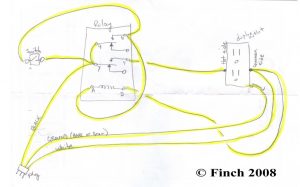Recently a new danger has emerged in the reef keeping hobby… flooding. Okay so flooding itself has been around since day 1 of the hobby, but a new wave of flood problems is entering the hobby.
The Problem
New methods of high power skimming feature large volumes of air injected or drawn into water columns. These skimmers work great when they are functioning properly. Unfortunately these skimmers are prone to overflow and malfunction. One of the most common problems is over injection of air following a power outage. During a power outage the feed pump to the skimmer shuts off and the skimmer water level often drains down. Once the power returns the water level begins to rise but this happens at the same time as the over injection of air. This produces an overflow of bubbles which many hobbyists (including the author) have had come pouring out the skimmer (several gallons of water over flowing).
The Fix
For this project I contact expert reef hobbyist and engineer Jon Finch. Jon has a real gift for ingenuity. Like so many times before, Jon came through. He designed the The Finch Shutoff Relay. This electrical devices was designed by Jon to match my criteria 1) when the power goes off the system is shut down 2) when the power comes back on the device stays shut down 3) the system can be easily restarted and 4) the system continues to run until the next power outage.
Jon designed this circuit using a 110 volt relay wired to form a holding circuit. Once the relay is energized the circuit is held closed by the relay. If power is cut to the relay the contact drops and the circuit is broken (open). In order for the circuit re-activate you would have to re-energize the relay. This is a perfect fix for my problem.
Here is how it works (non electrical perspective)
My skimmer is running just fine. Then the power goes out. The skimmer shuts off. At some later time the power comes back on. This skimmer STAYS OFF until I physically push the reset button. Once I push the button the skimmer turns back on. This is very important because the skimmer only comes back on while I’m there watching it and controlling the air intake to prevent a flood. If I’m not there to push the button the skimmer STAYS OFF.
Here is how it works (electrical perspective)
Power (hot wire) runs to a relay terminal (fixed contact). Opposite this contact on the open sided moving contact the hot wire runs to the outlet. This means power is NOT running to the outlet until the armature is engaged and moves towards the open contact. This is not achieved until the coil is energized and the magnetic field pulls the moving armature to the contact. In order to energize the coil this device makes you push a momentary button.
In addition this devise is wired with a holding circuit so once activated (by the momentary button) the coil stays energized and will stay energized when the button is released. If this doesn’t make any sense to you don’t feel bad. It took me a good long while to understand the diagram.
Assembly Steps
I purchased all the parts for this project from two places. One was a local hardware store (shout out to Home Depot… I’m there a couple times per week) and the other was an electronic supply house. Added up the total parts list for this project cost me $35.
Needed Items:
- 15-20 am 110 volt relay
- Relay socket
- Momentary On/Off push button
- Double space max deep “old work” electrical outlet box
- Duplex Outlet
- Double outlet box cover (one side blank if you can find it)
- Extension cord and hook-up wire

Following Finch’s original wiring diagram and I compared my relay to the relay in his diagram and numbered my contacts accordingly. For instance my relay socket had the A and B coil terminals labeled as 7 and 8. Finch’s number 7 stationary contact was numbered 5 on my socket. So I made a comparison chart of how my relay socket corresponded to his diagram.
From there it was just a matter of connecting wires. Very easy, but with a ton of wire I took my time to make sure I not only had them all but had them in the correct places. WARNING- don’t do this yourself if you don’t know what you are doing. Find help, or hire someone. I want you to burn your house down and blame me for it. If that does happen, the least you can do is blame Jon and not me.
Make sure you keep track of which contacts are stationary and which contact points move. Assemble following the wiring diagram and insert into the outlet box. It takes some maneuvering but you can fit the relay and socket in there as well. Drill a hole in the blank side of the cover (I couldn’t find a blank sided cover) and you have a perfect place to put your reset button.

Conclusion
The Finch Shutoff Relay is a great electrical invention. This item will undoubtedly prevent many overflows (it has saved me already). If you are interested in building your own relay switch I recommend contacting Jon Finch directly. This friendly friend can be found at [email protected] or by contacting the author of this article.
Finally, a very big and personal “thank you” to Jon… not for designing this system but for his ongoing friendship.
Author Information
Adam Blundell M.S. is a hobbyist, lecturer, author, teacher, and research biologist. Adam works for the University of Utah in Pathology and in Marine Biology. Adam is also the director of the Aquatic & Terrestrial Research Team, a group which bridges the gap between hobbyists and scientists. Adam can be reached by email at [email protected]. © Blundell 2008



0 Comments